This article is more than 5 years old.
The author’s object in this work, was to place before the reader a constant succession of characters and incidents; to paint them in as vivid colours as he could command; and to render them, at the same time, life-like and amusing.
Charles Dickens
In February of 1836 the young publisher William Hall dropped in unannounced on Charles Dickens at his lodgings in Furnival’s Inn. The firm of Chapman and Hall wanted to hire the 24-year-old author to provide narrative for a new serial publication featuring illustrations by the popular caricaturist Robert Seymour.
Dickens had begun to make a name for himself as “Boz”, the author of satirical newspaper and magazine pieces. But for Chapman and Hall his narrative was of secondary importance to Seymour’s depictions of lower and middle-class Londoners engaged in sporting pastimes typically associated with the landed gentry. The young Dickens, however, had other ideas.
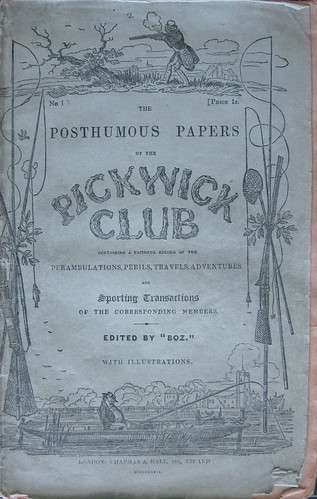 First part of The Pickwick Papers, April 1836
First part of The Pickwick Papers, April 1836
The serial was titled The Posthumous Papers of the Pickwick Club and was “edited by Boz”. Chapman and Hall published it in monthly issues beginning in April 1836 with part 1 and ending in November 1837 with a double issue containing parts 19 and 20. The first booklet, cheaply bound in green printed paper wrappers, contained four illustrations and about 20 pages of narrative. The monthly parts were priced at an affordable 1 shilling each.
Dickens was not, as undergraduate legend has it, paid by the word, but rather by the issue. His starting salary at Chapman and Hall was about £14 per month.
The first part of The Pickwick Papers was not a commercial success. Dickens’s narrative was disjointed and hastily written, and his characters– Samuel Pickwick and his motley assortment of friends and followers– were not yet well developed. Dickens’s relationship with Seymour was strained and became more so when, at a meeting arranged by the publishers, he criticized the illustrations for the second part. The hypersensitive and mentally unstable Seymour committed suicide the next day.
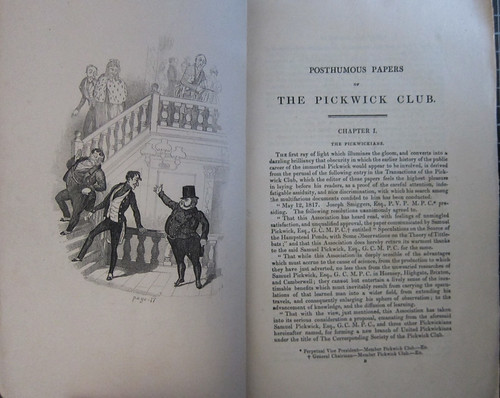 Illustration by Robert Seymour
Illustration by Robert Seymour
After the loss of their illustrator, Chapman, Hall, and Dickens reevaluated their plans for the publication. They decided to continue, but with Dickens’s narrative as the driving force, and with the number of illustrations in each issue reduced from four to two. R.W. Buss was hired to illustrate the third part, but he proved unsatisfactory. For the fourth part, young illustrator named Hablot Knight Browne was brought in. He soon adopted the pseudonym Phiz and embarked on a fruitful collaboration with Dickens.
The fourth part also introduced the character of Sam Weller, Pickwick’s comic manservant, who proved key to the development of Dickens’s story. The popularity of the serial took off, and by the end of the year the publishers had all they could do to keep up with demand for current and past issues of The Pickwick Papers. The relative cheapness of each issue meant that even working-class readers could afford to buy them.
Serial fiction was a new form of publication in the 1830s. Newspapers and magazines often featured installments of sensational stories, but novels were typically published as triple-deckers– three volumes published simultaneously– for the convenience of lending libraries. Pickwick was the first serially published work of fiction to gain widespread popularity, amongst a more socially and economically diverse group of readers than had ever been seen in Britain before.
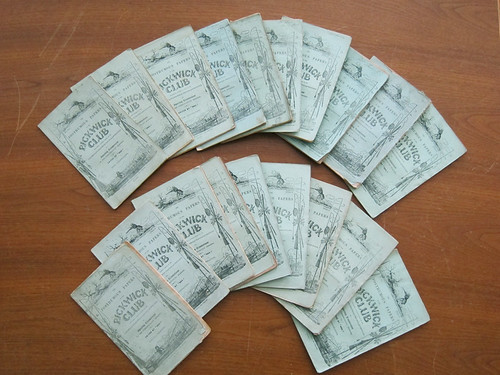 ZSR Library’s 19 separately issued parts of The Pickwick Papers, from the Charles Babcock collection
ZSR Library’s 19 separately issued parts of The Pickwick Papers, from the Charles Babcock collection
Publication in parts did present certain challenges to the author, which Dickens described in the Preface to the first book edition of Pickwick.
The publication of the book in monthly numbers, containing only thirty-two pages in each, rendered it an object of paramount importance that, while the different incidences were linked together by a chain of interest strong enough to prevent their appearing unconnected or impossible, the general design should be so simple as to sustain no injury from this detached and desultory form of publication, extending over no fewer than twenty months. In short, it was necessary — or it appeared so to the author — that every number should be, to a certain extent, complete in itself, and yet that the whole twenty numbers, when collected, should form one tolerably harmonious whole, each leading to the other by a gentle and not unnatural progress of adventure.
The experience of a 21st century student who encounters Dickens in a thick volume (perhaps with scholarly footnotes) is vastly different from that of the Victorian reader eagerly awaiting the next monthly installment of an exciting story! Dickens published most of his later novels in installments, and it was in the writing of Pickwick that he learned and mastered the form.
By 1837 Dickens had become so famous that when he had to delay the May issue following the death of his sister-in-law, his readers became distraught. The author had to address their concerns in a note in the June issue.
The popularity of Pickwick opened up a new source of revenue for its publishers: advertising. The first few issues featured only Chapman and Hall book notices on the back cover. But later issues contained “Pickwick Advertisers”– thick pamphlets advertising all manner of goods and services.
As the serial publication neared completion, Chapman and Hall began to advertise their single-volume edition of Pickwick.
The “new work” advertised was Nicholas Nickleby, which Chapman and Hall would begin publishing in serial form the next spring.
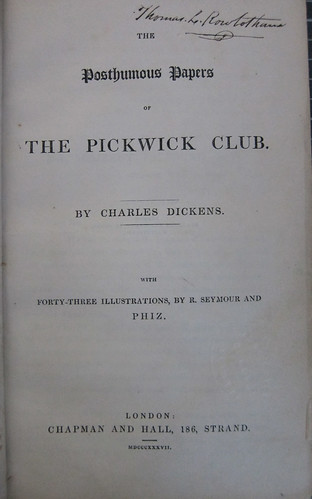 First edition of Pickwick as a single volume, 1837
First edition of Pickwick as a single volume, 1837
Pickwick proved as popular in book form as it had in parts. ZSR Library’s copy of the first edition has the signature of the English artist Thomas Leeson Rowbotham, who apparently opted for the half-morocco-with-marbled-edges option for the binding of his volume. It was donated to the Wake Forest College library early in the 20th century and has clearly seen some enthusiastic use.
February 7, 2012 marks the 200th anniversary of Charles Dickens’s birth. The author whose career was launched by The Pickwick Papers remains beloved by readers worldwide two centuries later.

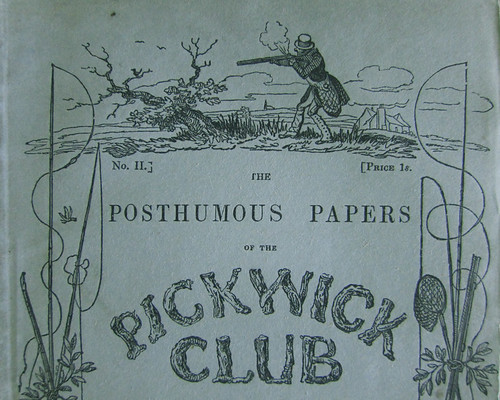
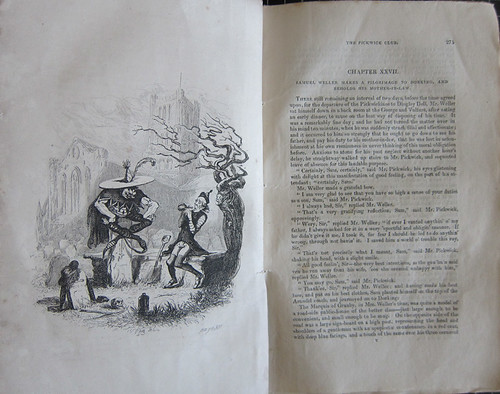
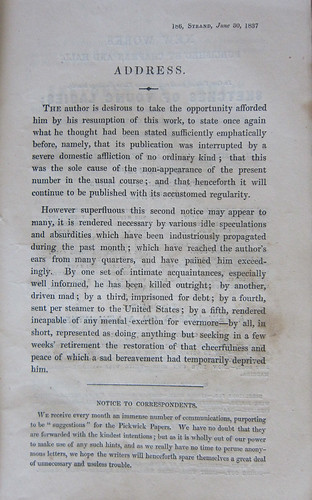
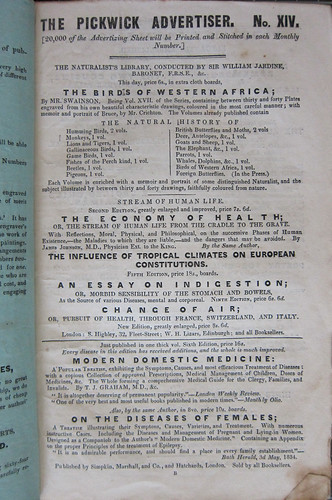
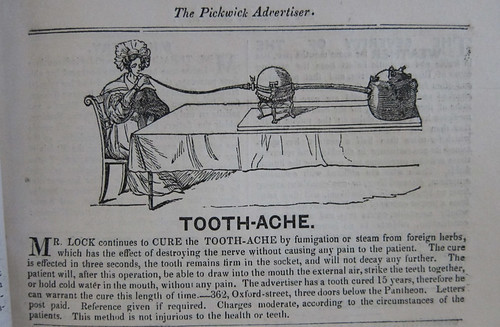
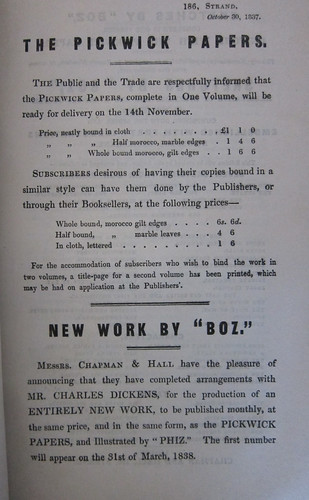
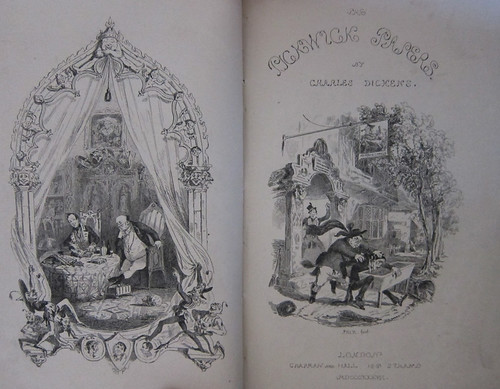
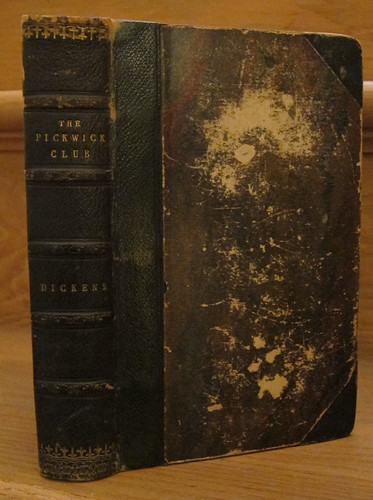
5 Comments on ‘The Posthumous Papers of the Pickwick Club, by Charles Dickens (1836-37)’
Wonderful! Great rare book of the month.
what a good tale you tell!
This is fascinating, Megan. Thanks for putting such effort into it. The pictures and narrative are great! Happy Birthday Mr. Dickens.
Thank you for this article. I love knowing the background of things we often take for granted.
Good to see this work being highlighted and written about so skillfully and informatively; I remember well those students delving into Dickens’ works! Good job, Megan!